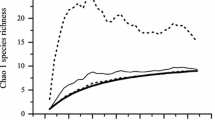Abstract
A survey of the filamentous fungi other than the symbiotic one found in association withAtta sexdens rubropilosa colonies was carried out. Different fungal species (27 taxa) were isolated a few days after treating the workers with toxic baits (sulfluramid; Mirex-S®), from 40 laboratory and 20 field nests.Syncephalastrum racemosum (54 %) andEscovopsis weberi (21 %),Trichoderma harzianum (38 %) andFusarium oxysporum (23 %) were the prevalent species in laboratory and field nests, respectively.Acremonium kiliense, Acremonium strictum, E. weberi, F. oxysporum, Fusarium solani, Moniliella suaveolens andT. harzianum were found in both nests’ groups. We revealed that many filamentous fungi can co-exist in a dormant state inside the nests of these insects and some of them appear to be tightly associated with this environment.
Similar content being viewed by others
References
Bacci M. Jr.,Ribeiro S.B., Casarotto M.E.F., Pagnocca F.C.: Biopolymer-degrading bacteria from nests of the leaf-cutting antAtta sexdens rubropilosa.Braz.J.Med.Biol.Res. 28, 79–82 (1995).
Bass M., Cherrett J.M.: The role of leaf-cutting ant workers (Hymenoptera: Formicidae) in fungus garden maintenance.Ecol.Entomol. 19, 215–220 (1994).
Carreiro S.C., Pagnocca F.C., Bueno O.C., Bacci M. Jr.,Hebling M.J.A., Silva O.A.: Yeasts associated with nests of the leaf-cutting antAtta sexdens rubropilosa Forel 1908.Antonie van Leeuwenhoek 71, 243–248 (1997).
Carreiro S.C.: Pesquisa de fator killer e análise da degradação de polissacarídeos vegetais por leveduras associadas aos ninhos deAtta sexdens. PhD Thesis. Universidade Estadual Paulista “Júlio de Mesquita Filho”, Rio Claro (Brazil) 2000.
Carreiro S.C., Pagnocca F.C., Bacci M. Jr.,Bueno O.C., Hebling M.J.A., Middelhoven W.J.: Occurrence of killer yeasts in leaf-cutting ant nests.Folia Microbiol. 47, 259–262 (2002).
Carreiro S.C., Pagnocca F.C., Bacci M. Jr.,Lachance Marc-André, Bueno O.C., Hebling M.J.A., Ruivo C.C.C., Rosa C.A.:Sympodiomyces attinorum sp.nov., a yeast species associated with nests of the leaf-cutting antAtta sexdens.Internat.J.Syst.Evol.Microbiol. 54, 1891–1894 (2004).
Craven S.E., Dix M.W., Michaels G.E.: Attine fungus gardens contain yeasts.Science 169, 184–186 (1970).
Currie C.R., Scott J.A., Summerbell R.C., Malloch D.: Fungus-growing ants use antibiotic-producing bacteria to control garden parasites.Nature 398, 701–704 (1999a).
Currie C.R., Mueller U.G., Malloch D.: The agricultural pathology of ant fungus gardens.Proc.Nat.Acad.Sci.USA 96, 7998–8002 (1999b).
Currie C.R.: Prevalence and impact of a virulent parasite on a tripartite mutualism.Oecologia 128, 99–106 (2001).
Currie C.R., Bot A.N.M., Boomsma J.J.: Experimental evidence of a tripartite mutualism: bacteria protect ant fungus gardens from specialized parasites.Oikos 101, 91–102 (2003a).
Currie C.R., Wong B., Stuart A.E., Schultz T.R., Rehner S.A., Mueller U.G., Sung Gi-Ho, Spatafora J.W., Straus N.A.: Ancient tripartite co-evolution in theAttini ant-microbe symbiosis.Science 299, 386–388 (2003b).
Domsch K.H., Gams W., Anderson T.:Compendium of Soil Fungi (2 Vols). Academic Press, London 1980.
Fisher P.J., Stradling D.J., Sutton B.C., Petrini L.E.: Microfungi in the fungus gardens of the leaf-cutting antAtta cephalotes: a preliminary study.Mycol.Res. 100, 541–546 (1996).
Gams W., Hoekstra E.S., Aptroot A.:CBS Course of Mycology, 4th ed. Centraalbureau voor Schimmelcultures, Baarn (The Netherlands) 1998.
Hölldobler B., Wilson E.O.:The Ants. The Belknap Press, Cambridge (USA) 1990.
Hughes W.H.O., Boomsma J.J.: Let or enemy do the work: within-host interactions between two fungal parasites of leaf-cutting ants.Proc.Roy.Soc.London B 271, S104-S106 (2004).
Lofgren C.S., Banks W.A., Glancey B.M.: Biology and control of imported fire ants.Ann.Rev.Entomol. 20, 1–30 (1975).
Middelhoven W.J., Fonseca A., Carreiro S.C., Pagnocca F.C., Bueno O.C.:Cryptococcus haglerorum sp.nov., an anamorphic basidiomycetous yeast isolated from nests of the leaf-cutting antAtta sexdens.Antonie van Lecuwenhoek 83, 167–174 (2003).
Möller A.: Die Pilzgärten einiger südamerikanischer Ameisen.Bot.Mittl.Trop. 6, 1–127 (1893).
Muchovej J.J., Della Lucia T.M.C.:Escovopsis, a new genus from leaf-cutting ant nests to replacePhialocladus nomen invalidum.Mycotaxon 37, 191–195 (1990).
Ortiz A., Madrigal A., Orduz S.: Evaluación del comportamiento de las hormigasAtta cephalotes (Hymenoptera: Formicidae) frente a la contaminación del jardín del hongo conTrichoderma lignorum.Rev.Colomb.Entomol. 150, 53–60 (1999).
Pagnocca F.C., Carreiro S.C., Bueno O.C., Hebling M.J.A., Silva O.A.: Microbiological changes in leaf-cutting ant nests fed on sesame leaves.J.Appl.Entomol. 120, 317–320 (1996).
Samson R.A., Hoekstra E.S., Frisvad J.C., Filtenborg O.:Introduction to Food-Borne Fungi, 4th ed. Centraalbureau voor Schimmelcultures, Baarn (The Netherlands) 1995.
Santos A.V., Dillon R.J., Dillon V.M., Reynolds S.E., Samuels R.I.: Occurrence of the antibiotic producing bacteriumBurkholderia sp. in colonies of the leaf-cutting antAtta sexdens rubropilosa.FEMS Microbiol.Lett. 239, 319–323 (2004).
Seifert K.A., Samson R.A., Chapela I.H.:Escovopsis aspergilloides, a rediscovered hyphomycete from leaf-cutting ant nests.Mycologia 87, 407–413 (1995).
Silva A., Bacci M. Jr.,Siqueira C.G., Bueno O.C., Pagnocca F.C., Hebling M.J.A.: Survival ofAtta sexdens workers on different food sources.J.Insect.Physiol. 49, 307–313 (2003).
Silva-Pinhati A.C.O., Bacci M. Jr.,Hinkle G., Sogin M.L., Pagnocca F.C., Martins V.G., Bueno O.C., Hebling M.J.A.: Low variation in ribosomal DNA and internal transcribed spacers of the symbiotic fungi of leaf-cutting ants (Attini: Formicidae).Brazil J.Med.Biol.Res. 37, 1463–1472 (2004).
Smith S., Onions A.H.S.:The Preservation and Maintenance of Living Fungi. Commonwealth Mycological Institute, Kew (UK) 1983.
Weber N.A.: Fungus-growing ants.Science 153, 587–604 (1966).
Weber N.A.:Gardening Ants: the Attines. American Philosophical Society, Philadelphia 1972.
Author information
Authors and Affiliations
Rights and permissions
About this article
Cite this article
Rodrigues, A., Pagnocca, F.C., Bacci, M. et al. Variability of non-mutualistic filamentous fungi associated withAtta sexdens rubropilosa nests. Folia Microbiol 50, 421–425 (2005). https://doi.org/10.1007/BF02931424
Received:
Revised:
Issue Date:
DOI: https://doi.org/10.1007/BF02931424



